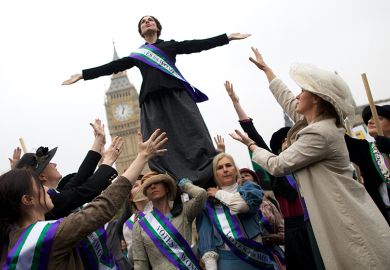Anti-sexist men do not have a particularly good press. For quite different reasons, both feminists and sexist men may be critical, even dismissive, of their intentions and efforts. Indeed, perhaps for this reason, the very notion of "anti-sexist men" still seems rather incongruous.
This book looks at the making of this contemporary minority through the words of the men themselves. It is a study of 30 men interviewed between 1988 and 1992. These are "men who either consciously or implicitly reject 'hegemonic masculinity' by attempting to live non-sexist lifestyles, and who believe in equality of the sexes. They are men who see themselves either as allies of feminists, or at any rate, as allies of women - whether accepted as such or not - in their fight against male domination".
Christian gathered his "anti-sexist" interviewees from a number of sources - men who had been in anti-sexist men's groups, men recommended as like-minded by those men, men known to have been supportive of women's events, and men who had taken on family caring and nurturing out of conviction. In so doing, he clearly distinguished "anti-sexist men" from "new men" ("a narcissistic man portrayed as macho with a 'soft centre', a man who takes an active part in childcare, at least when the camera is about") and the mythopoetic "wild man" image (which "seems to be part of a series of inward-looking 'men's liberation' activities which may perhaps be of benefit to some men, but are hardly to benefit women, and may even be part of the anti-feminist backlash" ).
The questions that the author addresses include: what kinds of men are attempting to change? What previous or current life experiences might be linked to these changes? And what are some of the difficulties or tensions in attempting to live non-sexist lifestyles? So who exactly are these "anti-sexist men" and what do they say?
Interestingly, the men interviewed came equally from manual and non-manual backgrounds. While most were in non-manual jobs, four were not employed, three were housepersons and primary childcarers, three were in manual work (although 11 had been in the past) and three others were studying or in part-time jobs. Most (26) defined themselves as heterosexual; all were white. Three-quarters were married or in stable relationships with women; two-thirds were fathers; eight were divorced.
The author suggests that the main finding of the interviews was that most of the men had experienced a combination of two interacting and reinforcing influences: early life experiences with some features that contradicted "traditional gender expectations" and adult experiences of feminism, usually a close relationship or friendship with at least one actively feminist woman. Both of these factors applied to 23 of the men, and all but two had experienced the second of these influences. Twenty of the heterosexual men had had a close relationship with at least one feminist.
So far, so good. However, following this initial analysis, the book shifts and there follows 130 pages (out of a total of 200) of the edited transcripts of interviews with eight of the men - two from non-manual backgrounds, three from manual, two gay men and one househusband.
These are certainly an interesting read but strangely, there is a complete lack of analysis of the intricacies of these eight men's accounts. More than that, there is no engagement with the critical issues that have been raised around autobiography in feminist and pro-feminist debate by, say, David Jackson in Masking Masculinity or Teresa Iles in All Sides of the Subject.
For example, the latter discusses how the writer might see herself as biographer, author, researcher or editor, and may see the biographee as subject or informant, who may in turn recognise herself as a "character" in someone else's text. There is no sense of such different subject positions in this book. Putting it another way, there is an assumption that the words speak for themselves. The spoken word is privileged, albeit through the written word. An authentic voice of men is assumed or sought. There are no women's voices in this book.
In the concluding chapter a number of interesting issues are briefly discussed. One is the suggestion by Christian that more attention needs to be given to the heterosexuality of "non-predatory heterosexual men". This is an interesting topic that could shed light on the significance of the relationship of heterosexuality and male power. However, again this issue is raised without reference to recent debates, such as those in the journal, Feminism and Psychology, or on "hegemonic/hierarchic heterosexuality".
Christian also looks at the significance of relations between younger and older men. As Christian notes: "Some of my male interviewees had suffered from patriarchy in the generational sense, and linked this oppression to women's oppression". He is quite right to urge greater attention to the interplay of generational and gender aspects. More studies of the intersection of ageism and patriarchy would be welcome.
Finally, there is very little attempt to place the biographical accounts of men's anti-sexism in a broader social context, either historically or cross-culturally. There is virtually no reference to the relatively large amount of anti-sexist men's writing, including autobiographical writing, that has appeared since the early 1970s. This is a curious omission, as there is a lot known about men from their own hand, and particularly of men who have been activists. Nor is there any attempt to analyse these accounts in relation to other examples of auto-critique, for example, of white people opposed to apartheid.
The phenomenon of "anti-sexist men" is usually thought of as a reaction by some men to second wave feminism. However, it is worth noting that with first wave feminism and before, there was a small number of men who did respond positively to women's demands, for example in their support for women's suffrage. The historical dimension of social change round men and (anti-) sexism is extremely important, especially so in terms of whether "anti-sexist men" might be maintaining or subverting patriarchal relations, or simultaneously and contradictorily doing both in different respects. As the author rightly says: "Men's anti-sexism involves a contradiction in that it is a political movement for giving up power - or at least 50 per cent of it."
Jeff Hearn is reader in sociology and critical studies on men, University of Bradford.
The Making of Anti-Sexist Men
Author - Harry Christian
ISBN - 0 415 09761 4 and 09762 2
Publisher - Routledge
Price - £37.50 and £12.99
Pages - 208pp
Register to continue
Why register?
- Registration is free and only takes a moment
- Once registered, you can read 3 articles a month
- Sign up for our newsletter
Subscribe
Or subscribe for unlimited access to:
- Unlimited access to news, views, insights & reviews
- Digital editions
- Digital access to THE’s university and college rankings analysis
Already registered or a current subscriber?



